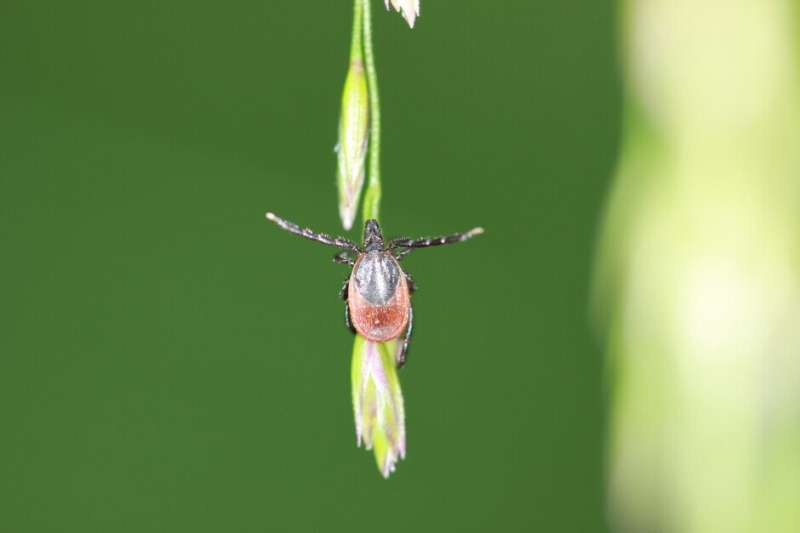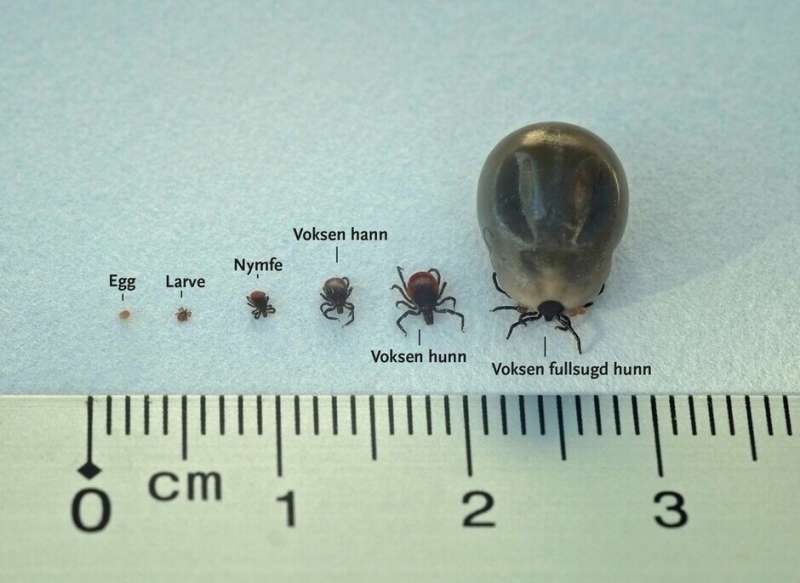This article has been reviewed according to Science X's editorial process and policies. Editors have highlighted the following attributes while ensuring the content's credibility:
fact-checked
proofread
Facts and myths about ticks

The tick is a parasite that feeds on blood. The good news is that a tick feeds only three times in its lifetime.
The tick has a lifespan of two to eight years and spends most of its time waiting. It waits to transform from larva to nymph after its first meal. It waits to become an adult after the second meal. The third meal is the last.
The tick larva is a tiny tick, not like elongated butterfly caterpillars, but as small as the smallest dot you can make with a pencil. As soon as it has eaten its fill, it falls to the ground. After a while it goes dormant to develop into a nymph.
The nymph goes through the same cycle: finds a meal, falls to the ground, hibernates and transforms into an adult.
Sucks blood while mating
Between meals, the tick waits to mate. The male tick waits for a potential mate in the fur of an animal. And while the female tick sucks blood, the male takes the opportunity to mate.
After mating, the female waits a few days before laying about 1,000 eggs. Then its life's task is done, and it dies. Now new ticks are on the way.
Every spring and summer these headlines appear in the newspapers. The tick has become bigger. It has become more dangerous. And now it's coming to get you.
Myths about ticks
UiA's associate professors Randi Eikeland and Vivian Kjelland are experienced tick researchers.
Eikeland is a doctor and neurologist and a specialist in tick-borne diseases. Her research is particularly concerned with how Lyme disease affects the nervous system.
Kjelland is a molecular biologist and tick researcher and has, among other things, studied which pathogens ticks carry.
The researchers say:
- No, the tick hasn't gotten bigger.
- No, it can't fly.
- No, it can't jump. No, it won't come after you.
The tick researchers tell us there are things we should be aware of:
- Yes, ticks can carry bacteria and viruses that could cause serious illnesses.
- Yes, you have to grab around it and pull it out to get rid of it.
- No, it cannot be brushed away like a mosquito, ant or a fly.
- No, it cannot be washed off in the shower.
- No, it won't die and won't let go if you go swimming in the sea.
- No, it doesn't die after sucking blood, it falls to the ground and if it is not already an adult, it transforms into a nymph or an adult tick.
- Yes, it will survive in the washing machine if you wash your clothes at 40 degrees or less.
- Yes, the male also sucks blood, but less than the female, and it will roam around more on its host because it is looking for a female tick to mate with.
In forests and gardens
The tick lives in the forest. It likes moist deciduous woodland and tall grass, but also open grassland and heather.
You can easily find it in your garden too. There are a lot of ticks especially along the coast in Eastern Norway, Agder and Rogaland. Tick season is from April to September.
Pets may crawl into bushes and thickets and bring them home with them.
Headless spider that feeds on blood
The tick has no eyes or nose. It has a biting tool where other arachnids have a head.
Kjelland points out that it is not an insect but belongs to the spider family and is a parasite.
The tick feeds on the blood of mammals, birds and reptiles. It needs blood in its intestines to survive and grow.

Anesthetize before biting
The tick sits on a blade of grass or in the shrubs. There it waits to grab hold of somebody passing by.
It will gladly take a man's foot if it can get hold of one. Or a woman's foot. Mouse, Toad. Hare. Roe deer. Moose. Blood is blood to the tick.
With the claws on the front two of its eight legs, it grabs hold of its prey. It quickly crawls to an area to bite, preferably where the skin is thin. The knees, inner thighs, neck, behind the ear. There it bites and sucks blood.
"You often notice it when it crawls on your skin, especially if it is an adult tick. But you won't notice it when it bites. It will numb the bite site so that it can suck blood in peace," Kjelland says.
Senses with front legs
Without eyes and nose, the tick is dependent on sensing its surroundings. It senses with a sensory apparatus on the forelegs which is called Haller's organ.
The sensory organ helps the tick to sense smells and vibrations in the air. It also has some areas on its back, so-called photoreceptors, which help it distinguish between light and dark.
"They probably suck day and night once they have attached themselves to the prey," says Kjelland.
Tick bites do not cause itching to help the tick avoid from being scratched away. Therefore, it is important to get blood while they are sitting on the prey and before the prey notices that it is tickling.
Infection from ticks
The tick sucks blood and regurgitates excess blood (blood plasma). As it spits back the blood plasma and its own saliva, the prey can be infected with Lyme disease, other bacteria and the TBE virus (tick-borne encephalitis).
Bacteria and viruses which the tick has ingested from mice and other animals can be transferred to humans. Each year, 400–500 people become ill from Lyme disease in Norway. The TBE virus usually causes illness in around 40–50 people annually, but last year more than 80 people fell ill.
"Both diseases can cause serious symptoms and long-term suffering. It is therefore important to be aware of ticks and take the necessary precautions," says Eikeland.
Attacks the nervous system
Lyme disease attacks the peripheral nervous system, and affects the arms and legs, skin and muscles. The disease can be cured with antibiotics.
The TBE virus attacks the central nervous system, the brain and spinal cord. The virus cannot be treated with antibiotics or other medicine.
Randi Eikeland, who has studied the effects of tick bites on humans since 2004, recommends vaccination against the TBE virus for those who are exposed to many bites and who live along the coast from the Swedish border in Halden to Flekkefjord.
The vaccine requires a prescription from your general practioner, and Eikeland points out that it does not protect against ticks or Lyme disease, so you cannot skip the daily tick check.
"In Austria, they've had a vaccination program against TBE for several years for children as young as 1–2 years old. This has led to fewer infections by the TBE virus in Austria," Eikeland says.
This is how to avoid ticks
Here are some smart precautions to take if you stay in areas with a lot of ticks:
- Be careful after you've been in a grassy or brush covered area.
- Check your entire body if you've been in an area with a lot of ticks, especially where the skin is thin.
- Comb through your hair with a lice comb.
- Pull ticks off as soon as you spot them. Use your nails, don't wait until you've bought tweezers. It does not matter if part of the tick is left. The most important thing is to remove it quickly to prevent the bacteria from being transmitted from the tick to you.
- Clean the site of the tick bite with ointment.
- Talk to the vet and get tick repellents for your dog or cat and brush regularly to remove ticks crawling on their fur.
















